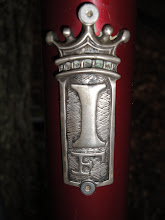Make sure that you check that you have EVERYTHING before you head to Easton for the weekend. DON'T presume that your bike shoes still are in the car from the Sea Gull weekend. Otherwise, you'll have to write about something other than biking.
 Big changes out here in the last two weeks. During the Sea Gull, the leaves had barely begun to change, and the fall waterfowl were just starting to make an appearance. This weekend was a full Fall experience. The ducks were plentiful on the water, and the geese were everywhere -- fattening up on the cleared cornfields, flying overhead in large Vs, and cruising the waters in flotillas. The sound hasn't become constant yet -- but that's coming.
Big changes out here in the last two weeks. During the Sea Gull, the leaves had barely begun to change, and the fall waterfowl were just starting to make an appearance. This weekend was a full Fall experience. The ducks were plentiful on the water, and the geese were everywhere -- fattening up on the cleared cornfields, flying overhead in large Vs, and cruising the waters in flotillas. The sound hasn't become constant yet -- but that's coming. We're now proud participants in the Department of Natural Resources "Marylanders Grow Oysters" program. We've got three cages full of oyster spat hanging in the water off of our dock. Each cage is supposed to grow 150 to 200 oysters, which will be collected next year and placed in protected oyster beds in the Tred Avon River. (No, we're not supposed to eat any of them). In addition to being rather tasty, oysters are an important part of the Bay's ecosystem, because they filter the water. A single oyster can filter 2 gallons of water in an hour. The Bay's oyster population used to be so large that it filtered the Bay's entire water volume every three to four days. Today that would take nearly a year. So every little bit helps.
We're now proud participants in the Department of Natural Resources "Marylanders Grow Oysters" program. We've got three cages full of oyster spat hanging in the water off of our dock. Each cage is supposed to grow 150 to 200 oysters, which will be collected next year and placed in protected oyster beds in the Tred Avon River. (No, we're not supposed to eat any of them). In addition to being rather tasty, oysters are an important part of the Bay's ecosystem, because they filter the water. A single oyster can filter 2 gallons of water in an hour. The Bay's oyster population used to be so large that it filtered the Bay's entire water volume every three to four days. Today that would take nearly a year. So every little bit helps.  Something else I've learned in my time in Easton is that those supposedly charming reeds along the water's edge actually are an invasive species called phragmites, which grows so thick that it chokes out other plants and wildlife. We had a heavy stand along much of our shoreline, and we discovered that the state and the county have a herbicide program to kill phragmites. We had the spraying done this fall, and it looks like it worked -- the plants have dried up and appear dead to the roots. I went out on Sunday with the hedge clipper and started to cut them down. They are very thick, and it will take a while to complete the task. Clearing the phragmites showed that there are a number of other plants along our shoreline -- some flowering bushes and some small evergreens. We'll have to see how things go in the Spring -- whether, without the phragmites, we suffer any erosion of the mud banks.
Something else I've learned in my time in Easton is that those supposedly charming reeds along the water's edge actually are an invasive species called phragmites, which grows so thick that it chokes out other plants and wildlife. We had a heavy stand along much of our shoreline, and we discovered that the state and the county have a herbicide program to kill phragmites. We had the spraying done this fall, and it looks like it worked -- the plants have dried up and appear dead to the roots. I went out on Sunday with the hedge clipper and started to cut them down. They are very thick, and it will take a while to complete the task. Clearing the phragmites showed that there are a number of other plants along our shoreline -- some flowering bushes and some small evergreens. We'll have to see how things go in the Spring -- whether, without the phragmites, we suffer any erosion of the mud banks.That's all for now. Next time, I'll remember my bike shoes

No comments:
Post a Comment